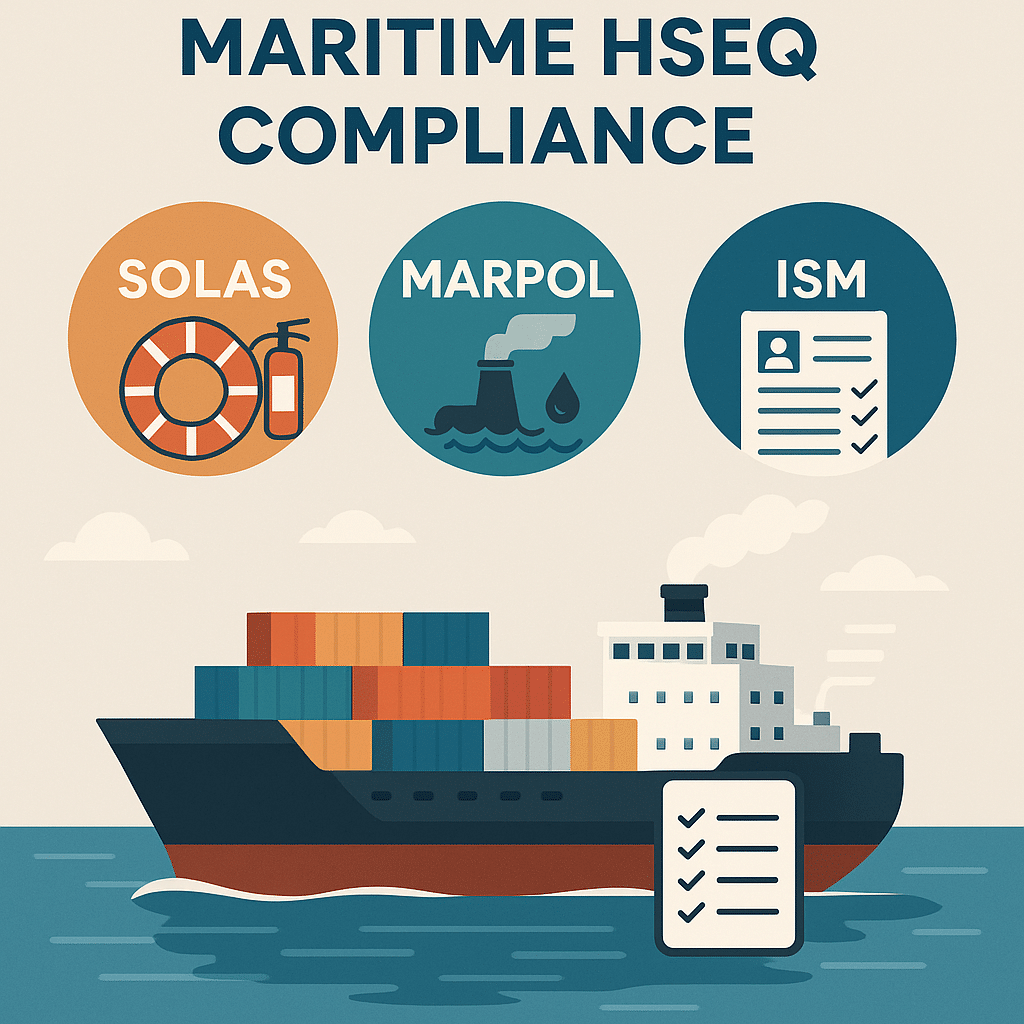Maritime HSEQ Compliance is essential to ensure the safety of lives at sea, protect the marine environment, and maintain operational excellence.
The maritime industry is governed by several international frameworks that lay the groundwork for Health, Safety, Environment, and Quality (HSEQ) compliance.

Among the most influential are SOLAS (Safety of Life at Sea), MARPOL (Marine Pollution), and the ISM Code (International Safety Management). These frameworks guide vessel owners, operators, and crews in maintaining high safety standards and reducing environmental risks.
In this article, we explore how Maritime HSEQ Compliance operates through these three key regulations and what it means for global shipping.
The Pillars of Maritime HSEQ Compliance
Understanding SOLAS: Safety First on Every Voyage
The International Convention for the Safety of Life at Sea (SOLAS) is often regarded as the cornerstone of maritime safety. It was first adopted in 1914 following the Titanic disaster and has since evolved into a comprehensive safety regime.
SOLAS sets minimum safety standards in the construction, equipment, and operation of merchant ships. From life-saving appliances and fire protection systems to navigational safety and emergency drills, SOLAS ensures that every vessel is equipped to deal with threats at sea.
Key SOLAS elements relevant to HSEQ include:
- Mandatory safety drills and training
- Lifeboat and life jacket availability and maintenance
- Emergency response planning and communication protocols
Compliance with SOLAS contributes to occupational safety, preventing accidents that could harm crew members and jeopardize cargo.
✅ Explore SOLAS regulations on the IMO website (DoFollow link)
MARPOL: Guarding the Marine Environment
The International Convention for the Prevention of Pollution from Ships (MARPOL) plays a critical role in the environmental aspect of Maritime HSEQ Compliance.
Introduced in 1973 and modified by the 1978 Protocol, MARPOL targets pollution from oil, chemicals, sewage, garbage, and air emissions.
With increasing concerns over climate change and ocean health, MARPOL’s six Annexes form the backbone of marine environmental compliance:
- Annex I – Prevention of pollution by oil
- Annex II – Control of pollution by noxious liquid substances
- Annex III – Harmful substances in packaged form
- Annex IV – Sewage discharge regulations
- Annex V – Garbage management
- Annex VI – Air pollution and greenhouse gas emission controls
Effective implementation of MARPOL is not just a legal obligation; it’s a corporate social responsibility. It calls for investment in cleaner fuels, onboard waste treatment systems, and crew awareness programs.
🌐 Check out the full MARPOL guidelines from the International Maritime Organization (IMO) (DoFollow link)
ISM Code: Systematic Safety Management
The International Safety Management (ISM) Code, introduced under SOLAS Chapter IX, shifts the focus from reactive compliance to proactive risk management. It mandates that shipping companies implement a Safety Management System (SMS) addressing:
- Company safety and environmental protection policy
- Defined responsibilities from ship to shore
- Emergency preparedness procedures
- Reporting, investigation, and corrective actions
- Document control and internal audits
By integrating health, safety, and environmental policies into a unified framework, the ISM Code improves accountability and promotes a culture of continuous improvement.
The ISM Code also requires designated persons ashore (DPAs) to monitor shipboard activities and ensure compliance. This creates a vital communication link between onshore and shipboard management.
Integrating the Three: A Holistic HSEQ Approach
Maritime HSEQ Compliance doesn’t treat SOLAS, MARPOL, and ISM as isolated silos. Instead, these conventions are interconnected, forming a comprehensive safety and environmental protection matrix.
For instance:
- SOLAS mandates the equipment, training, and processes that make emergency responses effective.
- MARPOL sets the environmental requirements that must be embedded into the ISM’s Safety Management System.
- ISM Code enforces compliance by requiring procedures and audits for both SOLAS and MARPOL regulations.
This interconnected approach ensures a robust maritime HSEQ culture, where operational safety, environmental responsibility, and quality management coexist.
Real-World Challenges in Maritime HSEQ Compliance
Despite these regulations, achieving full HSEQ compliance in maritime operations presents challenges:
- Varying national interpretations of IMO guidelines
- Resource limitations on smaller vessels
- Crew fatigue and insufficient training
- Lack of integration between shipboard and onshore systems
Addressing these issues requires investment in training, modern equipment, and digital compliance tools.
🔗 Read more on how digital tools support HSEQ at OHSE.ca (Internal link)
Technologies Enhancing HSEQ Compliance at Sea
The digital transformation in maritime operations offers innovative solutions for HSEQ compliance:
- Electronic chart systems and route optimization for safer navigation (SOLAS)
- Emission monitoring systems for MARPOL Annex VI compliance
- HSEQ compliance software that supports ISM documentation, audits, and real-time reporting
Crew safety apps, wearable devices for health monitoring, and AI-powered inspections are also being explored to enhance onboard safety culture.
The Future of Maritime HSEQ Compliance
With growing environmental scrutiny and the push for zero emissions shipping, HSEQ compliance will evolve beyond checklists. The IMO 2030 and 2050 decarbonization goals will make environmental compliance even more central to HSEQ strategies.
We can expect:
- Tighter enforcement of MARPOL emission limits
- Broader ISM code updates to address cyber security
- Integration of ESG (Environmental, Social, Governance) principles into HSEQ
Shipowners and operators who proactively enhance their Maritime HSEQ Compliance not only avoid penalties but also gain competitive advantage, public trust, and crew loyalty.
Conclusion: Navigating HSEQ Toward Safer Seas
Maritime HSEQ Compliance is far more than meeting regulatory demands. It’s about building a resilient maritime culture that values life, protects the oceans, and strives for excellence. Understanding and integrating SOLAS, MARPOL, and ISM into everyday operations is a strategic necessity in modern shipping.
By embedding these frameworks into your vessel’s DNA, you create a system that protects your crew, vessel, cargo, and the global environment—anchoring your operations in safety and sustainability.
Leave a Reply